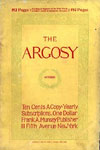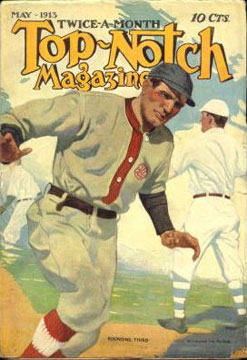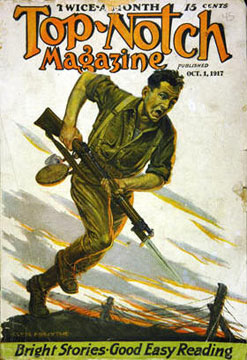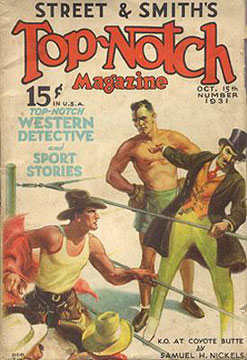Top-Notch Magazine
The first issue of Top-Notch Magazine appeared in March 1910. It began as a magazine for teenagers and, even as a pulp, concentrated mostly on sports stories, before switching to a men's adventure magazine in the 1930s. During its twenty-seven year run, the magazine was published twice-monthly, and became one of Street & Smith's circulation leaders in the pulp market, directly behind The Popular Magazine and People's Magazine. Top-Notch featured such notable authors as Jack London, Gilbert Patten, Octavus Roy Cohen, Arthur Conan Doyle, Robert E. Howard, L. Ron Hubbard, Lester Dent, and Harry Stephen Keeler. Lester Dent, the prolific pulp writer from Tulsa, Oklahoma most famous for his Doc Savage series, saw his first publication in Top-Notch with the short story "Robot Cay" in the September 1929 issue.
Originally published in a 36-page, nickel-library format for five cents, at the outset Street & Smith intended Top-Notch to be a short-lived strategy to continue Tip Top Weekly—the popular Frank and Dick Merriwell dime-novel series—without having to give into the federal government's threatened postal office regulations. The new magazine was edited under the name "Burt L. Standish"—the pseudonym under which Gilbert Patten printed his Merriwell stories. In fact, Patten not only was Top-Notch's first editor, but also came up with its name and wrote a large amount of the material that it published, such as his series about college life starring Cliff Sterling that was published under the pen-name Julian St. Dare. During Patten's editorship, Top-Notch published a full-length novel in each issue, along with a few short stories and serials; it was also during this period that the magazine marketed itself as juvenile fiction. A 1910 issue of The Bookseller advertised the magazine as being full of "clean American tales" and stories "that boys love."
In November 1910, after it had become clear that Top-Notch Magazine was going to be a success, Harry W. Thomas took over the editorship. Street & Smith continued, however, to publish the magazine under the name Burt L. Standish. Thomas converted Top-Notch into a standard 192-page pulp format that sold for 10 cents; he also attempted to move the magazine away from the juvenile market. Top-Notch eventually became a men's adventure magazine, and published some of the earliest pulp sports fiction, which would become a staple of the magazine throughout its history. Top-Notch also published a variety of westerns, detective, and general-interest fiction. After 1933, each issue of the magazine notably included a science-fiction story as well, under the influence of its editor F. Orlin Tremaine, who also edited Astounding Science Fiction. Top-Notch ran for a total of 602 issues, before folding in October 1937.
Alexandra Blair, The University of Mississippi
Works Cited and Consulted
Anderson, Ryan K. "What Would Frank Merriwell Do?": Middle-Class Readers and the Progressive Era Roots of All-American Boyhood. ProQuest, 2006.
Ashley, Michael, and Robert A.W. Lowndes. The Gernsback Days. Rockville, MD: Wildside Press LLC, 2004.
The Bookseller, Newsdealer and Stationer. Vol. 32, No. 1. (1 January 1910): p. 169.
Mullen, R.D. "From Standard Magazines to Pulps and Big Slicks: A Note on the History of US General and Fiction Magazines." Science Fiction Studies. Vol. 22, No. 1 (March 1995): pp. 144-156.
Sampson, Robert. Yesterday's Faces: Dangerous Horizons. Volume 5. Bowling Green, OH: The Popular Press, 1991.





